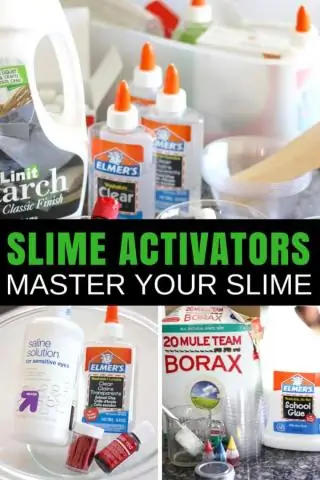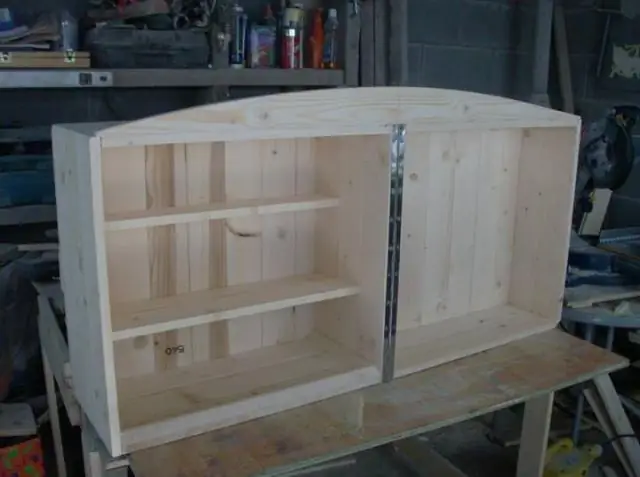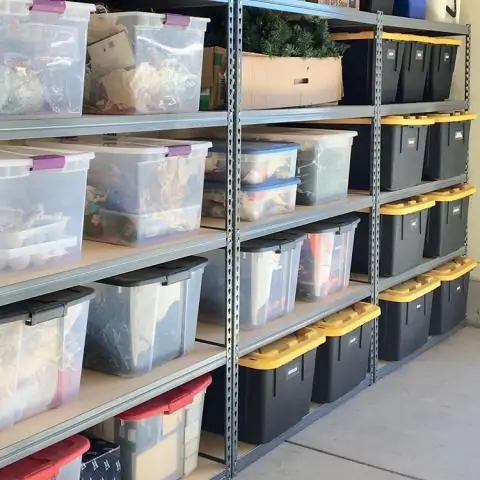
Table of contents:
- Author Bailey Albertson [email protected].
- Public 2023-12-17 12:53.
- Last modified 2025-01-23 12:41.
Hand gum or hand ghost - how to make a slime yourself

Slime is the happiness of children of the 90s of the last century and the nightmare of their parents. The toy received the name "slimer" after the release of the film "Ghostbusters", where one of the characters bore this name. The little voracious ghost ate everything that came in its path, crashed at speed into a cake on all sorts of obstacles and loved to kiss slobberly. For the resemblance to this screen character, the toy fell in love with children. And now many of them are purchased by slimes in stores, and those who are more economical and more inventive make their own at home.
Content
- 1 What is this strange toy
-
2 How to make different types of slimes at home
- 2.1 From sodium tetraborate and PVA glue
- 2.2 With foam for hair or shaving
- 2.3 From PVA glue and soda
- 2.4 From alcohol and silicate glue
-
2.5 From starch and hydrogen peroxide
2.5.1 Video instruction for making slimes from glue
- 2.6 From glue "Titan" and shampoo
-
2.7 From glue stick
2.7.1 Two video recipes for slime preparation
- 2.8 From plasticine
- 2.9 From toothpaste and liquid soap
- 2.10 From soap and shampoo
- 2.11 From hand cream and perfume
-
2.12 From flour
2.12.1 Video experiments on making slimes from different ingredients
- 3 How to give the slime the desired properties
- 4 Storage and maintenance rules
What is this strange toy
If you see on sale a plastic jar or container filled with a jelly-like substance with the inscription "Slime" or "Slime" on the package, then this is it. You can only understand what it is by picking up the slime. It is soft to the touch, wrinkles and stretches well, sticks to walls, and then slides off them, often leaving greasy spots.
Left alone, the slime spreads over the surface in a puddle, but is easily collected by hands into a ball. It can stick to your hands, flow through your fingers, but become elastic when it hits the wall.
The slime was originally made from guar gum, a polysaccharide, and sodium tetraborate, better known as borax. The result was a mucus-like material with the properties of a non-Newtonian fluid. It does not spread, it is easy to assemble, and when struck, it compresses.
There are many types of slimes, here are some of them:
Slime. A jelly-like mass is usually transparent. Does not stick to hands, flows through fingers in long threads, spreads over a hard surface into a puddle.

Slime is soft and stringy
Antistress. This is mucus, placed in an elastic membrane covered with a mesh net. Forms bubbles when pressed.

Slime "antistruss" well relieves nervous tension
Gum for hands. A denser elastic mass. It is easy to wrinkle and stretch.

Chewing gum for hands is more dense and elastic
Bouncer. The densest slime. It is less elastic, but elastic. Bounces off hard surfaces.

The resilient bouncer bounces off hard surfaces well
Fluffy slime. Fluffy and very pleasant to the touch. Crumples well, stretches.

Fluffy slime is the most lush and airy slime
Plasticine. It retains its shape better than others. Due to its plasticity, various figures can be sculpted from it.

Plasticine keeps its shape better than others
There are slimes that adhere well to surfaces, matte, transparent, with foam balls, mother-of-pearl, luminous, of various colors.
Of course, such a toy can be bought in a store, but it is more interesting to make it yourself from improvised means. Moreover, this is not difficult to do.
How to make different types of slimes at home
What the industry makes modern slimes from is not known for certain, but that when using sodium tetraborate at home, the substance turns out to be very similar to a purchased toy - a fact. Let's start with this recipe.
From sodium tetraborate and PVA glue
Let's prepare all the ingredients:
- borax (sodium tetraborate) - 0.5 tsp powder;
- PVA stationery glue - 30 g;
- dye (you can use greenery);
-
water - 1 glass.

PVA glue, borax and dye Three ingredients are enough to make slime
- Dissolve borax powder in water.
- Mix the dye and glue in a separate container. Add the dye little by little, stirring thoroughly until you get the desired color.
-
Without stopping stirring, gradually add borax solution into the glue. You will see how the mass becomes transparent and dense - borax acts as a thickener.

Slime with sodium tetraborate Slime from PVA glue and borax turns out to be no worse than magagin
Now you can pick it up, pull it, crush it, throw it and collect it again - the slime is ready.
Advice! When choosing a dye, remember that some of them get your hands dirty.
With foam for hair or shaving
Fluffy slime is made according to the same recipe. To add fluffiness to the slime, a hair or shaving foam is added to the composition.
- Pour the glue into a suitable container.
- Attach the foam to it. the amount depends on how fluffy the mass should be. Stir.
- Add dye, you can use aniline or any other. Mix thoroughly again.
- Pour sodium tetraborate into the mixture little by little while stirring. As soon as the composition thickens enough and begins to lag behind the walls of the dishes, you can pick it up and play.
The main condition for success in the manufacture of this type is good glue. If it does not thicken, all the work will go down the drain, nothing will work.
From PVA glue and soda
But not only borax is used as a thickener. Baking soda does this very well.
- Dissolve the baking soda in a little water.
- Pour the glue into a bowl, add the dye and stir.
- Add the baking soda solution a little while stirring thoroughly. Wait for the mass to thicken. This will not happen immediately, so do not rush to add more soda solution.
- Knead the prepared mass in your hands. It will turn out to be even softer and more tender than the previous one, it wrinkles and stretches well.

Slime can be made shimmery by adding glitter to it
From alcohol and silicate glue
Used for making slime and silicate glue. But the properties of the toy will be different.
- Pour the glue into a bowl and color with any dye.
- Stir in a circular motion and add a little alcohol. You will see how the mass thickens, forming dense lumps.
- Leave the substance to rest for 20 minutes.
- Gather in a ball and knead well with your hands. Such a slime will not stretch and stick, its consistency is quite dense. But it will make a great bouncy.
- Roll the mass into a ball and try to hit the floor with it. The resilient ball rebounds well from hard surfaces.
From starch and hydrogen peroxide
A hard bouncing ball is easy to make using ordinary starch. This does not require large expenses, the toy will cost a penny.
- Mix 100 g of starch with 200 ml of hot water until a jelly-like mass is obtained.
- Let cool and combine with 100 ml of PVA glue.
- Add a suitable dye and a few drops of hydrogen peroxide. Mix everything well. Hydrogen peroxide will give the toy lightness and airiness.
- Roll the resulting mass into a ball. The bouncer is ready.
Video instruction for making slimes from glue
From glue "Titan" and shampoo
A simple way to make slime is with Titan glue. This glue is non-toxic and does not lose its elasticity after drying.
- Mix the glue and shampoo in a 3: 2 ratio. The color and clarity of the toy will depend on the shampoo used. Add dye for more color intensity.
- Leave the mixture to thicken for a while, usually 5 minutes.
- The slime is ready. Simple and fast.
This recipe does not always manage to get the desired result, different shampoos behave differently. But it's worth a try, because you don't lose anything.
Advice! Stir the mixture until it will not lag behind the walls of the dish and no longer stick to your hands. These are signs that the toy is ready.
From glue stick
Another type of glue, a pencil, is also quite applicable for this purpose. Here again we need sodium tetraborate.
- This will require 4 pieces of glue stick. Remove the rods and place in a fireproof dish.
- Using the microwave or oven, melt the rods to form a viscous mass.
- Add dye to the glue mass, mix.
- In a separate bowl, dissolve borax in a little water.
- Add the mortar to the glue little by little with constant stirring until the desired consistency is obtained.
Two video recipes for cooking slime
From plasticine
Slime can be made not only from glue. A good and durable toy is made from plasticine.
You will need:
- plasticine - 100 g;
- gelatin - 15 g;
- water - 250 ml.
- Soak gelatin in 200 ml of cold water using a fireproof dish.
- When the gelatin swells, bring it to a boil on slow heating and immediately remove from heat. Let cool slightly.
- Mash up the clay to soften it. Mix with remaining water.
- Combine still warm gelatin with plasticine, mix well until a homogeneous mass is obtained.
- Place in the refrigerator for half an hour.
Such a toy can be safely given to children, because there are no harmful substances in its composition. There is a small problem: this look leaves greasy spots on the wallpaper. Make sure children do not throw it into walls.
From toothpaste and liquid soap
A completely safe option is a toothpaste slime. You can use regular and gel paste.
- Mix 20 ml each toothpaste and liquid soap with 5 teaspoons of flour.
- Stir so that there are no lumps first with a spoon and then with your hands. To prevent the mass from sticking to your hands, moisten them with water and knead well again.
From soap and shampoo
For the next type, you need only two ingredients that can be found in any home. It is a liquid soap and hair shampoo.
- Mix liquid soap and shampoo in equal proportions until smooth.
- Place in the refrigerator for 24 hours.
- Get it out and have fun.
As this slime is composed of water-soluble substances, keep it dry. The toy quickly softens from the warmth of the hands; it must be stored in the refrigerator. And do not allow contact with dust and dirt, it will not be possible to wash the slime. With a careful attitude, such a toy will last about a month.
From hand cream and perfume
You can even make a slime from hand cream. There is no guarantee that the toy will work, but it's worth a try.
- Squeeze the cream into a bowl.
- Add paint and stir.
- Slowly adding perfume, mix everything thoroughly. The mixture will begin to thicken.
- After achieving the desired consistency, knead the toy with your hands.
Of flour
Often, parents are afraid to give slime to young children for fear that they will pull it into their mouths. For such a case, you can make a completely safe, edible slime without chemicals.
For this you will need:
- flour - 400 g;
- cold water - 50 ml;
- hot water - 50 ml;
- food coloring.
- Sift flour into a bowl, mix with dry color.
- Add cold water, stir again.
- Pour in hot water, knead the resulting dough well. It should come out smooth and free of lumps.
- Refrigerate the dough for a few hours.
- Knead well again with your hands.
Not all products and substances are suitable for making slime. Not everything that looks like a slime has the necessary properties. To avoid making mistakes, watch the video.
Video experiments on making slimes from different ingredients
How to give the slime the desired properties
Even if the slime is not what you wanted, you can fix it.
- The vinegar will make the toy more elastic. Pour in a few drops and the slime will stretch better.
- By adding hydrogen peroxide, you get a fluffy mass, this is how a fluffy slime is made.
- A few drops of glycerin will help make the toy slippery.
- Glowing Slime can be obtained by using fluorescent paint.
- If the slime is too soft, place it in a jar, put a few crystals of salt in it, close the lid tightly and leave it overnight. The salt will draw out excess water and give the toy its elasticity.
- Slime that is too hard will be softer if you put it in a container overnight and pour in a few drops of water.
- To keep the toy smelling good, flavor it with essential oil, food flavor, or vanilla.
- A magnetic slime can be made by adding fine metal filings or iron oxide to it. Knead the toy well to distribute the additive evenly. And then your slime, as if alive, will be drawn to any magnet.
- An antistress toy is made by putting mucus in a balloon. This can be done with a large syringe without a needle.
- To enlarge the slime, place it in a container of water for 3 hours. Do not be alarmed if it falls apart, it should be. Add some salt and hand or body cream. Stir. Slime will not only restore elasticity, but also become larger.
Advice! Add colorful foam balls to the soft slime. This will make it colorful and increase in volume.
Storage and care rules
Slime is a capricious toy and its life span is short. To prolong it, you need to know how to properly store and care for the slime.
- Slime is stored in a plastic container with a tightly closed lid.
- To prevent the slime from drying out, keep it away from heat sources, do not leave it in the sun.
- Dried slime can be revived with a drop of water, wet with salt.
- You need to play with the slime. Long-term storage can lead to mold. Such a toy will have to be thrown away.
- Frequent use will lead to rapid contamination of the toy and loss of properties.
- Avoid contact with fuzzy surfaces, the slime will collect hairs and become unusable.
Slimes are not just a child's toy; some species have practical applications. For example, they can clean a computer keyboard or clothes from adhering debris. Elastic ones develop fine motor skills, increase finger strength. And they just calm down, relieve stress and give a good mood. Make slimes and play, it's so exciting!
Recommended:
How To Make A Bar Stool With Your Own Hands From Wood, Metal And Other Materials + Drawings, Photos And Videos

Bar stools manufacturing options. Required tools, materials used. Step-by-step description of the manufacturing process with a photo
How To Make A Shed With Your Own Hands From Foam Blocks - Instructions With Photos And Videos

Every owner knows about the need for a barn on the territory of home ownership. Everyone can build this necessary outbuilding without the involvement of specialists
How To Make Garden Benches With Your Own Hands From Pallets, Pallets And Other Materials At Hand - Step By Step Instructions With Photos, Videos And Drawings

Do-it-yourself construction of classy garden benches from pallets, old chairs and other improvised materials: step-by-step instructions, drawings, photos, videos
How To Make A Shelf In A Bathhouse With Your Own Hands - A Step-by-step Guide On Making A Bench And Other Furniture With Photos, Videos And Drawings

How to make a shelf for a bath with your own hands: the choice of material and instructions with drawings. A step-by-step guide to assembling a bench and other furniture
What Can Replace Sodium Tetraborate For Slime (lizun)

What mixtures can replace sodium tetraborate in the manufacture of slime, slime, handgam at home
